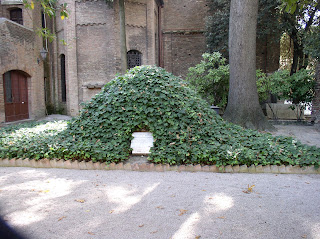After Parma, I returned to Florence for a few days, happy to stay again with Carmel and Pino at their hotel, Il Bargellino. The first night back, they invited me to a yummy dinner of homemade polenta con porcini (mushrooms), made by Pino's friend. Lucky me! We watched Italy's version of "Funniest Videos" while we ate, usually one of my all-time least favorite TV shows. But we laughed a lot, and it was nice sharing a meal with them. The weather had turned colder over the weekend and the city was less crowded, though there were quite a few Norwegian Cruise tour groups seeing the sights that Monday, a day when many museums are closed.
I flew out at 8 a.m. on Tuesday morning, and spent the next 19 hours en route to my home, via London and Minneapolis. Long waits between flights, and Gatwick airport was an uncomfortable, cold zoo. In comparison, the Minneapolis airport was serene and enjoyable. Once I arrived in Kansas City, the shuttle picked me up and I was home by 8 p.m., gaining seven hours on the return flight. Jet lag hasn't been too bad, but I still feel a bit disoriented. I wasn't eager to leave Italy, but I was a bit weary from traveling around, so now I can rest for a few months before I start thinking about the next journey.....Venice, maybe? Anyone want to go with?
 |
| On the terrace at Il Bargellino, Florence. |
One of the treasures I came home with is a Moka Express espresso coffee maker, Lavazza coffee, and intricate instructions on how to make good espresso from two Italian men. The first man was the owner of the store where I bought the coffeemaker. Sure, I can find one in downtown Lawrence, but I wanted one from an Italian store. The store clerk took great care to help me decide which model to buy, steering me away from the more expensive ones, and describing in detail how to use it. He was very attentive, and I wandered around the store while he showed me a photo of his grandmother as a little girl with her parents, standing in front of the store when it opened. When I had chosen several items to buy, I told him they were intended as gifts, and he carefully wrapped each one in wrapping paper and ribbons.
In Urbino, I noticed a similar thing on Sunday morning, as people walked by carefully holding packages wrapped in red, green or pink paper and tied with a ribbon. Turns out it was their purchases from the nearby pasticceria (pastry store): gift-wrapped packages of dolci (sweets) for the Sunday meal. In Bologna, the purchases we made at the Majani chocolate store were also wrapped neatly and tied with ribbons. It's a simple elegance that we don't see often in the States.
OK, let's get back to coffee...when I got back to the hotel, I inquired about what kind of coffee to use, and Pino told me what to buy and where to find it, then gave me even more specific instructions on how to "cure" the coffeemaker, how to fill it and use it properly for the best taste. Italian coffee is quite delicious and unlike anything I've found in the U.S. I can't hope to replicate the flavor without one of their magical espresso machines, but perhaps I can learn to make a reasonable facsimile. Chissa? Speriamo! (Who knows...let's hope so!)
 |
| A couple with their morning pastries in Urbino. |
One of the last places I visited in Firenze was Mercato Centrale, where you can find many colorful displays of all kinds of fresh food.
















































